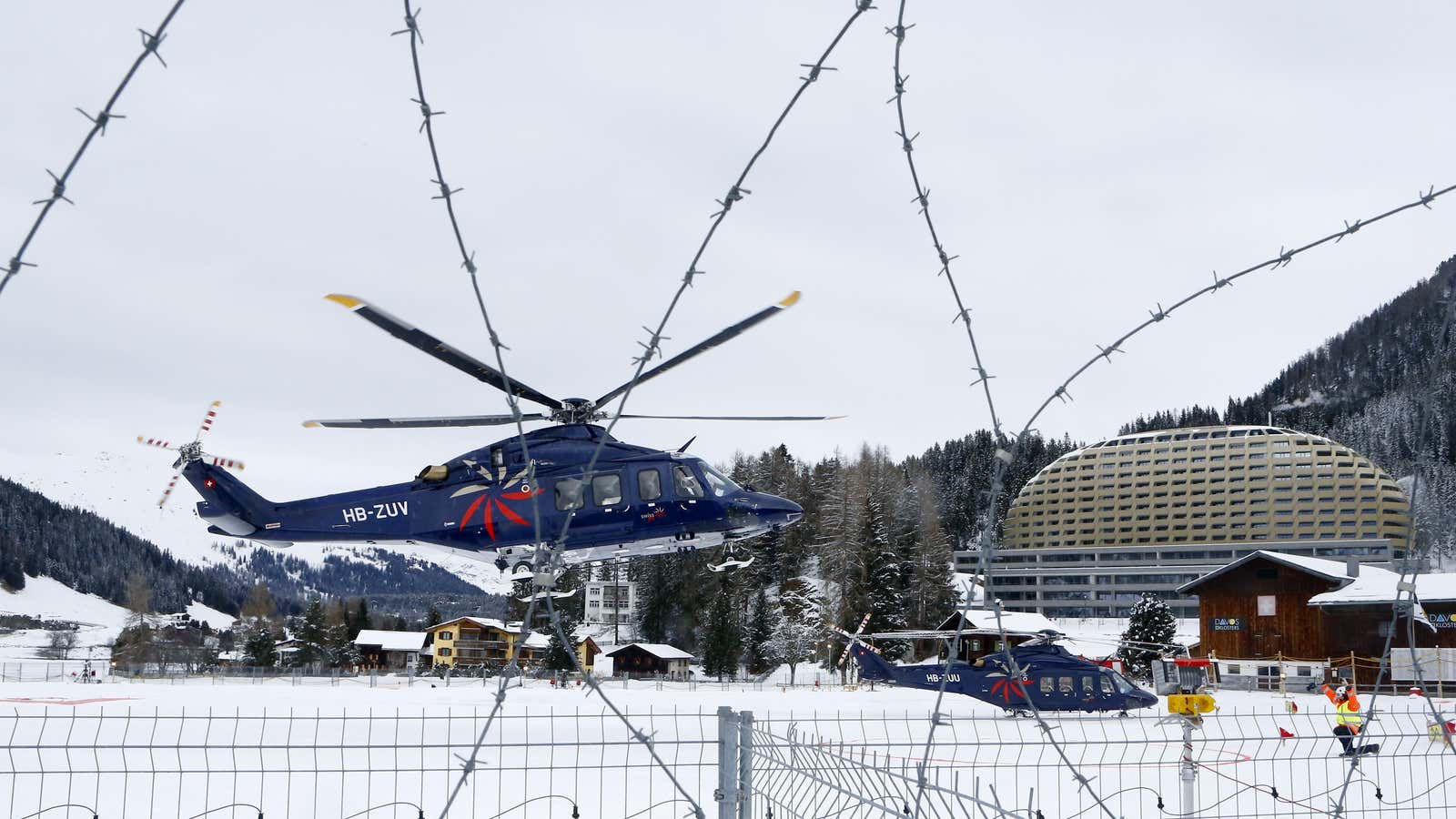Davos, Switzerland
The World Economic Forum’s annual meeting here attracts a high-flying set of attendees. This year, Quartz endeavored to discover just how high-flying these Davos men and women are by tracking private helicopter travel in and out of the Alpine town during the conference.
To do that, we built an antenna and installed it at our apartment in Davos from Jan. 19, the day before the event officially began, to its conclusion on Jan. 23. The device captured more than 2 million transmissions, most of them from commercial airliners flying overhead.
Amid all the data, we were able to identify 16 private helicopters flying around the area during the conference, likely shuttling Davos attendees to and from nearby airports.
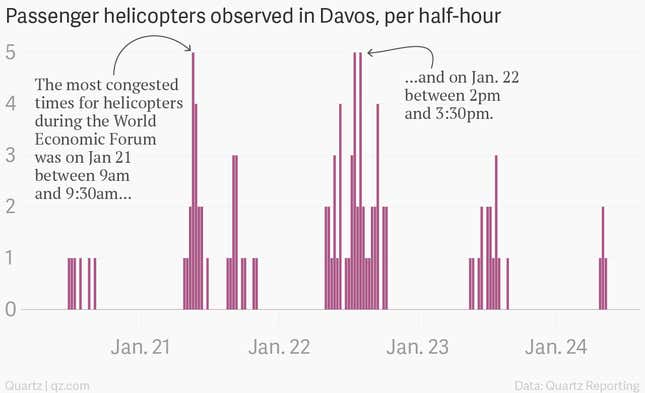
We went to all this trouble because there is perennial fascination with the flying habits of the 2,800 Davos delegates. Use of private aircraft, though often wildly overstated, highlights the vast wealth and power that descends upon this small skiing town in the Swiss Alps each year. And their transportation choices are frequently criticized for their environmental impact at a conference that seeks solutions to reducing carbon emissions, among other topics.
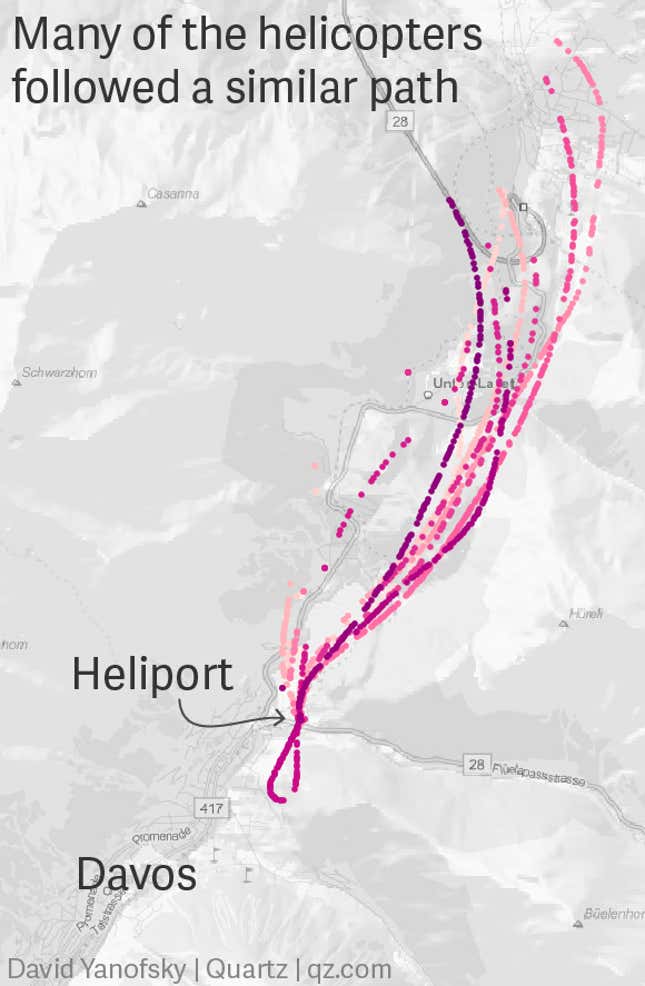
Private jets don’t land in Davos. People attending the conference generally fly into one of three nearby airports. Most get the rest of the way by ground, but some fly into Davos by helicopter, so we focused our efforts on picking up signals from those trips. Flying from the Zürich airport to the main heliport in Davos—the route that ride-sharing app Uber offered this year—takes about 40 minutes. Two airports mostly used by private jets, St. Gallen–Altenrhein and Engadin, are a little closer.
Chartering a helicopter flight from Zürich to Davos can cost as much as $10,000. We built our helicopter-tracking rig for under $200. The antenna was constructed out of segments of coaxial cable that is more typically used to connect satellite dishes to televisions. It was hooked up to a USB device that digitizes radio signals and a Raspberry Pi computer running open-source software to decode the aircraft transmissions that were picked up by the antenna.
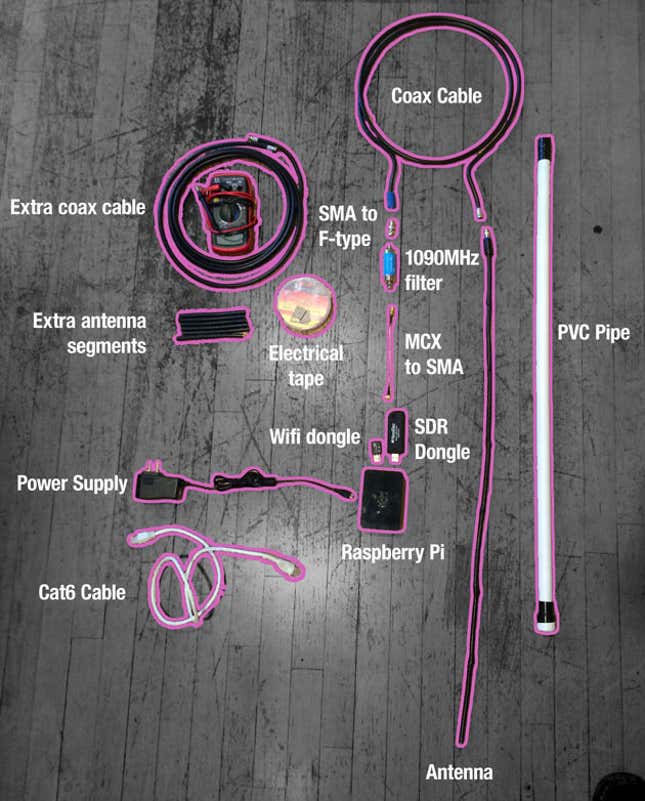
The broadcasts we listened for are known as ADS-B squitters and can contain information about an aircraft’s location, elevation, speed, and more. If you have ever tracked a flight using websites like Flightradar24 or FlightAware, you have taken advantage of these signals picked up by amateur aircraft spotters around the world.
But while planes are widely tracked, helicopters are harder to keep tabs on because they rarely operate on set schedules and can take off and land from a wide variety of locations, not just airports. Helicopters typically fly at low altitudes, which can prevent their signals from traveling as far, and their broadcasts often contain less data about their whereabouts.
We were able to identify signals from helicopters by cross-referencing against the Swiss aircraft registry and other public databases. We excluded Swiss government, military, and rescue helicopters for the purposes of our analysis. That left us with at least 16 different helicopters, of 12 varieties, flying around Davos during the conference.
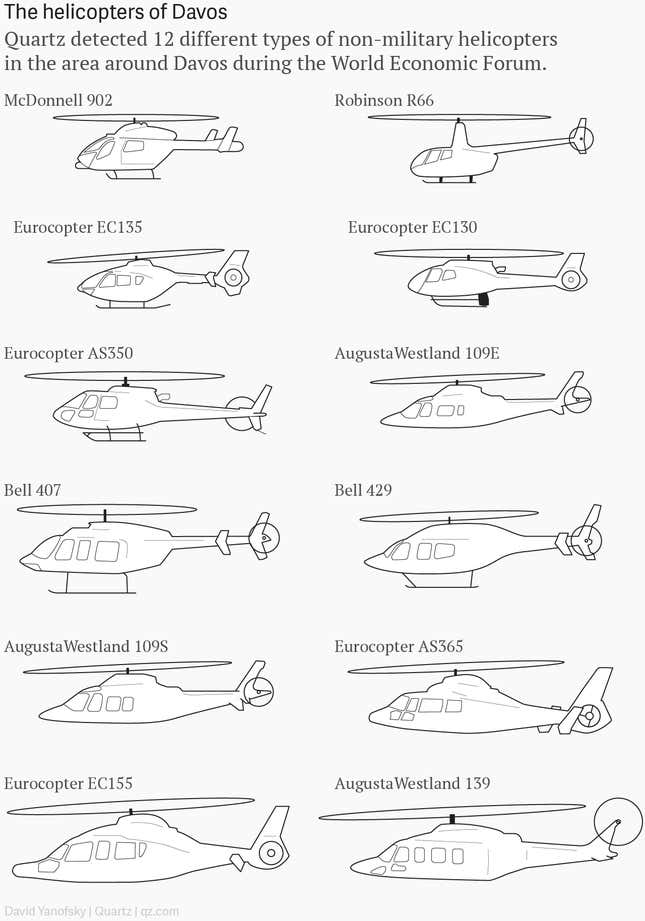
The helicopters ranged from a luxurious Agusta Westland AW139, with room for 12 passengers, to a more basic, four-passenger Robinson R66. The most common private helicopter was an AS 350. (We also observed two med-evac helicopters, two Swiss Air Force helicopters, one helicopter of the Swiss Confederation, and one US Army helicopter.)
It is impossible to determine the purpose of any particular flight or its passengers based on these data. Many of the operators of the helicopters we observed offer a full range of services from airport transfers to sightseeing and heliskiing.
Adrian Monck, a spokesman for the World Economic Forum, said his understanding was that all helicopters flying into Davos are used by heads of government, who numbered over 40 this year’s annual meeting. But even that is no guarantee: Monck said the British delegation, which included prime minister David Cameron, was forced to drive into town because of poor weather conditions.
Weather stymied other attendees this year and may have diminished overall helicopter activity. “There was definitely much less helicopter traffic this year,” said a publicist who spent time shepherding CEOs around the swanky InterContinental hotel, which is adjacent to the main helipad in Davos. He spoke with three people whose plans to take helicopters into Davos were scotched by bad weather and overheard “a lot of complex triangulation” among delegations discussing how to get their VIPs out of town by chopper.
Monika Baumgartner, a spokeswoman for the InterContinental, wouldn’t discuss how guests had arrived but said she wasn’t aware of any complaints about noise from the helicopters.
Here is some amateur footage shot in 2011 that shows various helicopters taking off and landing at the Davos helipad:
Our antenna almost certainly missed some helicopter travel into Davos, such as aircraft that did not have or turned off their transponders. And some aircraft only broadcast their unique identifier, making it impossible to determine their location more precisely than the range of our device. That range has shown to be up to 75 miles (120 km) for tracking airplanes at cruising altitude but is likely much shorter for helicopters because mountains block transmissions from lower-flying craft. Helicopters that broadcast their locations flew out of the range of our antenna when they around 6 miles (10 km) away from our antenna, which was about 3 miles (5 km) from the main helipad in Davos.
David Yanofsky reported from Los Angeles and Jason Karaian from Davos.
